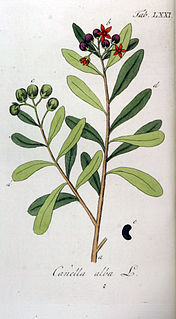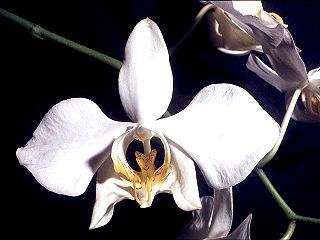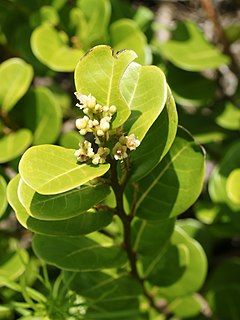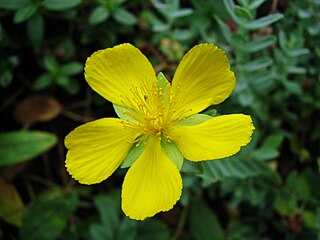
Euphorbia is a very large and diverse genus of flowering plants, commonly called spurge, in the spurge family (Euphorbiaceae). "Euphorbia" is sometimes used in ordinary English to collectively refer to all members of Euphorbiaceae, not just to members of the genus. Some euphorbias are commercially widely available, such as poinsettias at Christmas. Some are commonly cultivated as ornamentals, or collected and highly valued for the aesthetic appearance of their unique floral structures, such as the crown of thorns plant. Euphorbias from the deserts of Southern Africa and Madagascar have evolved physical characteristics and forms similar to cacti of North and South America, so they are often incorrectly referred to as cacti. Some are used as ornamentals in landscaping, because of beautiful or striking overall forms, and drought and heat tolerance.

Syringa (lilac) is a genus of 12 currently recognized species of flowering woody plants in the olive family (Oleaceae), native to woodland and scrub from southeastern Europe to eastern Asia, and widely and commonly cultivated in temperate areas elsewhere.

Psidium is a genus of trees and shrubs in the family Myrtaceae. It is native to warmer parts of the Western Hemisphere.

The Canellaceae are a family of flowering plants in the order Canellales. The order includes only one other family, the Winteraceae. Canellaceae is native to the Afrotropical and Neotropical realms. They are small to medium trees, rarely shrubs, evergreen and aromatic. The flowers and fruit are often red.

Syringa vulgaris is a species of flowering plant in the olive family Oleaceae, native to the Balkan Peninsula, where it grows on rocky hills. Grown for its scented purple flowers in spring, this large shrub or small tree is widely cultivated and has been naturalized in parts of Europe and North America. It is not regarded as an aggressive species, found in the wild in widely scattered sites, usually in the vicinity of past or present human habitations.

Clethra is a genus of flowering shrubs or small trees described as a genus by Linnaeus in 1753.

Acer tataricum, the Tatar maple or Tatarian maple, is a species of maple widespread across central and southeastern Europe and temperate Asia, from Austria and Turkey east as far as Japan and the Russian Far East. The species is named after the Tatar peoples of southern Russia; the tree's name is similarly commonly also spelled "Tartar" in English.

Galium boreale or northern bedstraw is a plant species of the Rubiaceae. It is widespread over the temperate and subarctic regions of Europe, Asia and North America including most of Canada and the northern United States.

Phalaenopsis amabilis, commonly known as the moon orchid or moth orchid in India and as anggrek bulan in Indonesia, is a species of flowering plant in the orchid family Orchidaceae, native to the East Indies and Australia, and widely cultivated as a decorative houseplant. It is an epiphytic or lithophytic herb with long, thick roots, between two and eight thick, fleshy leaves with their bases hiding the stem and nearly flat, white, long-lasting flowers on a branching flowering stem with up to ten flowers on each branch.

Melaleuca viminalis, commonly known as weeping bottlebrush, or creek bottlebrush is a plant in the myrtle family, Myrtaceae and is endemic to New South Wales, Queensland and Western Australia. It is a multi-trunked, large shrub or tree with hard bark, often pendulous foliage and large numbers of bright red bottlebrush flowers in spring and summer. It is possibly the most commonly cultivated melaleuca in gardens and its cultivars are often grown in many countries.

Chrysobalanus is a genus of evergreen perennial shrubs to small trees, described as a genus by Linnaeus in 1753. It is native to sub-tropical and tropical regions of Africa, Latin America, and Florida.

Hypericum olympicum, commonly known as the Mount Olympus St. John's wort, is a species of flowering plant in the family Hypericaceae found in the Balkans and Turkey and introduced to western Europe. It has been widely cultivated for centuries because of its large, showy flowers, which are far larger that those of most other species in Hypericum.

Zephyranthes atamasca, commonly known as the atamasco-lily or more generally a rain-lily, is native to the southeastern United States. It grows in swampy forests and coastal prairies, preferring acid boggy soils rich with leaf mold. Following the appearance of broad, grassy leaves in early winter, it blooms in March or April. It has several narrow, linear basal leaves about 0.5 in (13 mm) wide and 10–15 in (25–38 cm) long. Its native range extends from Florida north to Maryland and west to Mississippi. The species is also naturalized in Bermuda and in the Mariana Islands. Both its leaves and bulbs are poisonous.

Brachyloma daphnoides, commonly known as daphne heath, is a small shrub in the family Ericaceae. The species has an upright habit, growing to between 0.4 and 1.5 metres in height. The leaves are 4 to 15 millimetres long and 1.7 to 3.6 millimetres wide. These are glossy green above and paler underneath. White flowers appear in the leaf axils between August and December in the species native range. These are tubular with a wider base. The rounded fruits are about 4 mm in diameter and are green or yellow brown. The species occurs in heath, woodland and forest in South Australia, Victoria, New South Wales and Queensland. It was first described by James Edward Smith, before being given its current binomial name by George Bentham in 1868.
Lissocarpa is a genus of flowering plants, described as a genus in 1876. It is classified as belonging to the family Ebenaceae, the ebony and diospyros family. It includes only a few species of small evergreen trees and shrubs species native to tropical South America.

Hymenocallis caribaea is a plant in the Amaryllidaceae with the common names "Caribbean spider-lily" or "variegated spider-lily." It is native to the islands of the Caribbean and to northern South America. It is regarded as native to Puerto Rico, Jamaica, Hispaniola, Cuba, the Virgin Islands, and the Windward and Leeward Islands, and the Venezuelan Antilles. It is also commonly cultivated as an ornamental in many other tropical and subtropical regions and reportedly naturalized in Sri Lanka, New South Wales, Bermuda, French Guinea, Suriname, and Guyana.
Myoporum mauritianum is a flowering plant in the figwort family Scrophulariaceae and is endemic to a few volcanic islands in the Indian Ocean. It is a small, low-branched shrub with serrated leaves and small white flowers and usually grows on calcarenite within 20 metres (70 ft) of the sea.
Pentacoelium bontioides commonly known as ku jian lan, is the only species of the monotypic flowering plant genus Pentacoelium in the family Scrophulariaceae. It is a shrub growing in coastal areas of southern Japan and South China including beaches and estuaries where there are no large breaking waves.

Hypericum coris, the heath-leaved St. John's wort, also called yellow coris, is a species of flowering plant in the genus Hypericum, and is the type species of sect. Coridium. It is a low shrub that grows close to the ground, and it is found in Switzerland and northwestern Italy. The species has been a popular garden plant since the 18th century, valued for its long flowering period and for how well it adapts to cultivation.

Scaevola plumieri is a species of plant in the family Goodeniaceae which grows on coastal dunes in the tropics and subtropics.


















